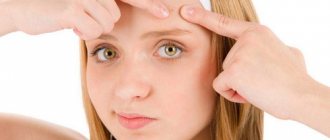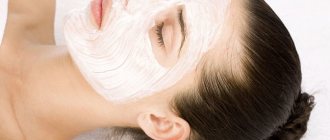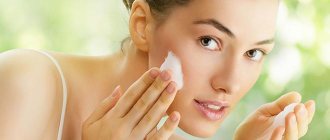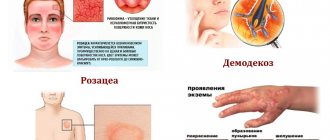The importance of following a diet for demodicosis
Most of these factors depend on proper nutrition and a healthy lifestyle.
Many patients suffering from demodicosis focus their treatment on taking special medications and ointments, neglecting the diet recommended by the attending physician.
However, it is proper nutrition that will help reduce the development of the mite and its growth under the skin.
Proper nutrition for skin diseases, based on eating healthy foods and avoiding harmful foods that provoke parasite activity, is an important component in the complex therapy of demodicosis.
Prohibited Products
With a skin pathology such as demodicosis, it is extremely important for patients to properly balance their diet. By eliminating all harmful foods from their usual diet, they can significantly complicate the life of parasites.
Without receiving the required amount of nutrients, ticks will lose their ability to reproduce, which means it will become easier to fight them.
Patients who have been diagnosed with facial demodicosis are prohibited from eating the following foods:
- fatty foods;
- smoked meats;
- any types of sweets;
- spicy foods and seasonings;
- It is advisable to reduce the amount of salt as much as possible.
The main nutrient for demodectic mites is glucose. That is why patients should minimize products containing it in their menu.
What must be excluded from the diet
Patients with demodicosis should not eat foods that disrupt the process of food digestion and metabolism, causing digestive disorders and increased blood glucose levels.
Prohibited products include:
- fatty, rich meat and fish broths;
- flour products - white bread, pasta;
- smoked, dried, spicy, salty dishes;
- canned vegetables and fruits;
- sweets – rich pastries, cakes, cream pies, chocolate, ice cream, jam, sweets, honey;
- fruits and berries - citrus fruits, bananas, grapes, strawberries, mango, pineapple, pomegranate, cranberries, red currants;
- vegetables – bell peppers, tomatoes, mushrooms;
- all types of sausages, sausages, bacon, brisket;
- spices and seasonings - mayonnaise, vinegar, mustard, sauces, ketchup;
- milk products - cream, full-fat sour cream, hard cheeses (especially blue cheeses), condensed milk;
- meat - lamb, pork, lard, duck, geese;
- fish – sardine, catfish, mackerel, salmon, salmon;
- seafood;
- carbonated sweet drinks;
- products containing preservatives, flavors, GMOs;
- instant semi-finished products;
- chips, crackers, dry snacks;
- alcohol.
How to enrich your diet
The main goal of the diet in the treatment of demodicosis is to restore the body’s protective functions to fight parasites and provide it with the necessary nutrients.
The patient's diet should contain the following products:
- fresh vegetables - zucchini, cabbage of all varieties, potatoes (limited), squash, onions, legumes, greens;
- lean meat and fish - turkey, rabbit, chicken, veal, pike perch, pollock, perch, hake;
- fermented milk products – cottage cheese, sour cream, kefir, yogurt, fermented baked milk, yogurt – fat content 1 – 3%;
- fruits - apples, nectarines, pears, kiwis, gooseberries, peaches;
- cereals – oatmeal, buckwheat, wheat, brown rice;
- drinks – tea with milk, green, herbal, fresh juices, still water, chicory;
- flaxseed, sesame, olive vegetable oil;
- whole grain bread, biscuits.
Your daily diet should include a large amount of fresh fruits and vegetables containing the fiber necessary for normal bowel function.
Features of nutrition for demodicosis (demodex, subcutaneous mite) ^
Demodicosis is a disease characterized by the appearance of mites in the sebaceous ducts and hair follicles of a person.
- Most often it appears with metabolic disorders, frequent stress and decreased immunity, and manifests itself in the form of redness and inflammation on the skin, the formation of papules and purulent rashes.
- The disease usually affects the forehead and eyelids, less often the back and roots of the eyelashes.
Is a diet necessary for demodicosis?
In order to prevent the spread of the tick, in addition to medications and treatment of demodicosis with folk remedies, a special diet is prescribed. Its essence lies in the use of certain products that block ticks’ access to other areas, and also contribute to their speedy destruction.
What is recommended to give preference during a therapeutic diet for demodicosis:
- Fruits and vegetables;
- Dairy products;
- Low-fat varieties of meat and fish;
- Cereals;
- Grain bread.
What should not be consumed when maintaining an effective diet for patients with demodicosis:
- Citrus fruits and honey - they can provoke an allergic reaction;
- Salty, sweet, smoked and spicy dishes.
Therapeutic nutrition for demodicosis has a beneficial effect on the entire body and improves intestinal function, and this, in turn, creates negative conditions for mites, as a result of which they simply die.
Thus, a diet for subcutaneous mites is not an additional treatment, but its main component, since without it the parasites can spread much faster, which is fraught with complications such as rhinophyma, damage to the cornea and the appearance of psychological problems.
Menu for the week
The organization of a diet for patients with skin diseases is based on compliance with certain rules:
- Eliminate simple carbohydrates and pure sugar.
- Limit salt intake.
- Replace fried, smoked, spicy foods with boiled, steamed or baked ones.
- Increase the amount of vegetables, fruits, and cereals in your diet.
- Regularly consume foods that contain live bacteria.
- Quit smoking and alcohol.
Nutrition should be varied, balanced, contain vitamins and microelements for the proper functioning of the digestive system, increasing immunity and vitality.
The diet includes 3 main meals - 1 - breakfast, 2 - lunch, 3 - dinner and 2 - 3 snacks between them - second breakfast, afternoon snack, second dinner.
Approximate dietary menu for a week for the treatment of demodicosis.
Monday:
- Oatmeal, steamed chicken cutlet, seaweed salad with olive oil, green tea.
- Vegetable soup, boiled beef, buckwheat porridge, rosehip tea.
- Stewed stew of vegetables - potatoes, zucchini, onions, cabbage, carrots.
Tuesday
- Rice porridge with dried apricots, curd soufflé, herbal tea.
- Broccoli soup, steamed turkey fillet, stewed zucchini, dried fruit tea without sugar.
- Chicken liver pate, mashed potatoes, green tea.
Wednesday
- Buckwheat porridge, veal meatballs, fresh vegetable salad, compote.
- Vegetable soup, cauliflower, steamed chicken breast, herbal tea.
- Vegetable casserole, Jerusalem artichoke salad.
Thursday
- Oatmeal porridge, fruit salad of peaches and pears, rosehip infusion.
- Rice cream soup, beef stew, baked eggplant caviar, chicory tea.
- Fish stewed with vegetables, kefir.
Friday
- Steamed omelette without yolks, wheat porridge, green tea.
- Cauliflower soup, buckwheat porridge, boiled chicken fillet, peach juice.
- Cheesecakes cooked in a double boiler, low-fat yogurt.
Saturday
- Millet porridge with baked apple, tea.
- Vegetable soup, mashed potatoes with stewed veal, tea with milk.
- Fresh vegetable salad, boiled fish, fruit.
Sunday
- Chicken pate, oatmeal, herbal tea.
- Bean soup, rabbit meatballs, salad of boiled vegetables with flaxseed oil.
- Fruit salad, wheat bran, tea.
Snacks between main meals should include:
- low-fat cottage cheese or dishes made from it - casseroles, steamed cheesecakes, soufflés;
- fruits and berries - apples, peaches, pears, gooseberries, nectarines, black currants;
- fermented milk products - yogurt, biokefir, yogurt.
During the day you need to drink 2 - 2.5 liters of liquid - pure still water, natural juices from vegetables or fruits, herbal and green teas, rosehip decoction.
It is recommended to take food in small portions and not to overeat.
Duration of diet
It is necessary to adhere to dietary rules during treatment, and for at least 2 months after recovery.
If the disease worsens, it is recommended to switch to a strict diet, including only fermented milk products, vegetables and fruits. Other dishes are excluded. You need to follow it for 7 – 8 days until there are visible signs of improvement.
After the skin condition has normalized, the diet is gradually expanded, carefully adding new products to the main menu in small portions.
How to diet for children and teenagers
Demodicosis in children develops for the same reasons as in adults. Dietary nutrition is based on the same principles, but has its own characteristics:
- If a breastfed baby gets sick, the nursing mother will have to follow the diet.
- For children under 2 years of age, some cooked foods need to be pureed or cut into small pieces.
- Parents of a child attending a kindergarten or school must warn the educational institution staff about the existing problems and organize separate meals for him.
Treatment of demodicosis in young children is complicated by the child’s reluctance to eat. To make feeding a pleasant experience for your baby, you can interest him in an unusual presentation of food: put berries on the porridge in the shape of a sun, build a chicken from boiled vegetables and cutlets, cut a multi-colored salad of fresh fruits with yogurt.
Proper nutrition is not the main therapy for skin lesions with demodicosis. Eating healthy foods and avoiding junk food has a positive effect on the results of treatment, shortens the recovery time of damaged skin, and helps you quickly return to a healthy lifestyle.
Causes and symptoms
The causative agent of the disease is a mite from the Demodex family. It parasitizes areas of the skin with active sebum secretion. Most often these are the eyelids, facial skin, eyebrow area, forehead and chin.
On a note! It is worth noting that demodicosis is more common among women. Provoking factors:
- oily skin;
- acne;
- age from 18 years;
- immunodeficiency diseases;
- genetic predisposition;
- use of topical corticosteroids on the skin of the face;
- the use of cosmetics that reduce the barrier function of the skin.
With demodicosis of the eyelids, swelling, redness and recurrent styes are observed. The patient complains of pain in the eyes. When the face is affected, the skin becomes oily and pores are clearly visible. The cheek and nose areas are most susceptible to negative effects.
Pustules, acne, pimples and red spots often occur. The rash may be accompanied by itching, tingling and other unpleasant sensations.
Nutrition for eyelid disease
An important part of treating demodicosis is proper nutrition.
Basic recommendations:
- It is necessary to constantly strengthen the immune system. The basis of the menu is vegetables and fruits.
- You should limit the amount of simple carbohydrates. A sweet environment is favorable for the proliferation of microorganisms.
- The diet should contain a large amount of foods rich in vitamins A, B, C, as well as amino acids and proteins.
- Food should contain sufficient fiber. It promotes normal bowel function and removes toxins.
- It is necessary to observe the drinking regime. You should drink at least 1.5 liters of liquid per day. The exact amount is calculated depending on body weight.
Meals should be fractional. Hypoallergenic products that do not contain thyroxine and histamine are recommended. You should limit the amount of salt and other foods that can irritate the intestines.
If the symptoms of demodicosis intensify, then you should switch to a dairy-vegetable diet. You must first consult with a specialist. It is necessary to adhere to proper nutrition for 7-10 days. Then the diet gradually expands.
Diet for demodicosis: list of allowed foods, sample menu, tips
Diet for demodicosis is an important part of treatment. This parasitic disease cannot be treated with medication alone. Demodex mites feed on subcutaneous fat.
The secretion of this substance largely depends on the consumption of certain foods. In addition, demodicosis occurs mostly in patients with a weakened immune system. To strengthen the immune system, proper nutrition is also required.
Next, we will consider in detail the principles of diet for this disease.
What is demodicosis
Normally, demodex mites live on human skin. It has microscopic dimensions. If the number of individuals in a skin area does not exceed the norm, then this does not lead to pathology.
In a healthy person, demodex does not penetrate the skin. Under certain conditions, the tick begins to actively reproduce. This is usually preceded by a decrease in immunity. Demodex penetrates deep into the skin and parasitizes there.
A disease occurs - demodicosis.
In the skin form of the pathology, the mite lives in the sebaceous glands and feeds on their secretions. In the ocular form, the parasite penetrates the eyelash bulbs and eats their protein, keratin. Most often, demodex is found on the face and eyelids.
Mite waste products cause an allergic reaction. The cutaneous form of the pathology is manifested by the following symptoms:
- the appearance of acne;
- severe itching of the skin, especially in the evening and at night;
- shiny skin due to excess secretion of sebum;
- redness of the affected areas;
- proliferation of the wings of the nose.
In the ocular form of demodicosis, the following clinical manifestations are noted:
- eye fatigue;
- redness and inflammation of the skin on the eyelids;
- formation of a sticky film on eyelashes.
A tick can be detected using a special study. A skin scraping is taken for analysis and the number of parasites per 1 cm2 of epidermis is calculated. If the number of adult individuals is more than five, then the diagnosis is considered confirmed.
Rosacea
Patients often believe that rosacea and demodicosis are the same disease. This is a misconception. Rosacea (rosacea) is not a parasitic pathology. The disease occurs due to dilation of facial blood vessels and is accompanied by reddish rashes on the face.
However, rosacea often provokes the development of demodicosis. Favorable conditions are created on the affected skin for increased mite activity. Therefore, these two pathologies often occur simultaneously in the same patient.
The principles of diet for demodicosis and rosacea are very similar. Both diseases are accompanied by skin inflammation and require limiting the same foods.
For demodicosis of the face, doctors prescribe local anti-mite medications (ointments, gels, shampoos), and for demodicosis of the eyelids, eye drops. They destroy parasites. A diet for demodicosis is necessary to maintain a good state of the immune system and skin, as well as to create unfavorable conditions for mite reproduction.
Is it possible to cure demodicosis with just one diet? This question often interests patients. Diet is a very important part of treatment, but it cannot replace drug therapy. It is impossible to get rid of ticks with proper nutrition alone.
What contributes to the development of the parasite
Let's try to understand the conditions conducive to the active reproduction of ticks. This will help to better understand the reasons for certain food restrictions provided for in the diet for demodicosis.
The following factors can provoke active reproduction of demodex:
- decreased immunity;
- increased secretion of the sebaceous glands;
- excessive consumption of fatty and sweet foods;
- intestinal diseases;
- skin inflammation;
- hormonal disorders.
The diet for demodicosis of the face or eyelids should be structured in such a way as to reduce the harmful effects of these factors.
General principles of diet
The following principles of therapeutic nutrition for demodicosis can be distinguished:
- Food should be rich in vitamins A, C and B, as well as proteins and amino acids. This will help strengthen the immune system.
- Food should contain sufficient fiber. Such food stimulates intestinal function and the removal of toxins.
- Dishes must be boiled or baked; frying is not allowed.
- The consumption of complex carbohydrates is recommended.
- You need to drink at least 1.5 liters of liquid per day.
- The patient should eat small meals and not overeat.
- Simple carbohydrates are limited. A sweet environment is favorable for tick reproduction.
- Food should be hypoallergenic and free of histamine and thyroxine. Products that promote the absorption of allergens are also limited.
- All products with artificial food additives are prohibited. They can also trigger allergies.
- Limit the consumption of salt and foods that irritate the stomach.
- Easily digestible carbohydrates are excluded from the diet, as they contribute to the inflammatory response.
- It is necessary to minimize the consumption of fats. Such foods contribute to excessive oiliness of the skin.
If the patient’s symptoms of demodicosis intensify, then it is necessary to switch to a dairy-vegetable diet. In this case, it is allowed to consume only fermented milk products and permitted vegetables and fruits. All other dishes should be excluded. This strict diet should be followed for about 7-10 days. Then you can gradually expand your diet.
Conditionally permitted products
These products should not be included in your daily menu. In the diet for demodicosis, they are not completely prohibited, but they can be eaten in small quantities and not daily.
Conditionally permitted products include:
- sweets: jam, sugar, jams, ice cream, sweets, confectionery;
- White rice;
- salt;
- semolina.
You should eat sweet foods with extreme caution. Such nutrition creates favorable conditions in the body for the reproduction of demodex.
Sample menu
How to create a sample menu for the week? The diet for demodicosis imposes many restrictions. However, even from a small list of permitted products you can create a varied and tasty menu.
You should eat at least 4 times a day. For breakfast, it is recommended to eat porridge with water and low-fat cottage cheese. For taste, you can add pieces of permitted fruits and berries. If a person is used to drinking coffee in the morning, then it can be replaced with green tea. This drink also promotes vigor and activity.
Light vegetable soups are prepared as a first course for lunch. For the main course, you can boil chicken breast, turkey fillet, rabbit or veal, and as a side dish prepare vegetable stew or mashed potatoes in water.
For an afternoon snack, you can eat fruit and drink a glass of kefir with crackers or unsweetened dry cookies.
For dinner, fish dishes with buckwheat or mashed potatoes are recommended. It is useful to prepare a vegetable salad. Only vegetable oil can be used as a dressing. For people prone to allergies, it is better to use boiled rather than fresh vegetables for salad.
For ocular form
Does the diet for demodicosis of the eyelids differ from the rules of nutrition for the skin form of the disease? After all, Demodex, which lives in the eye area, does not feed on subcutaneous fat. Is it necessary to exclude fats from the diet in this case?
The eyelids are also equipped with sebaceous glands. With demodicosis, the skin around the eyes is inflamed. It is extremely undesirable to increase the production of sebum; this can aggravate irritation of the eyelids.
Therefore, a patient with damage to the eyelids and eyelashes needs to adhere to the same food restrictions as with the cutaneous form of demodicosis. Excessive consumption of fats can lead to blockage of the sebaceous gland on the eyelid. This will cause severe inflammation and complicate the course of demodicosis.
Diet duration
It is often difficult for patients to follow a fairly strict diet with demodicosis. How many days should you adhere to food restrictions? This question interests many.
The diet must be followed for at least 2 months. Nutritional rules must be followed not only during the acute period of demodicosis, but also for some time after recovery. As your condition improves, your diet can be gradually expanded. It must be remembered that demodicosis often recurs, and any disturbance in nutrition can lead to activation of the mite.
Source: https://FB.ru/article/400895/dieta-pri-demodekoze-spisok-razreshennyih-produktov-primernoe-menyu-sovetyi
List of permitted and prohibited products
The diet for demodicosis is aimed at restoring the patient’s immune system. It is necessary to include foods high in vitamins and amino acids in your diet. Foods that irritate the gastrointestinal tract are prohibited. More details in the table below.
| Authorized Products | Forbidden food |
| vegetables; | cream; |
| unsweetened fruits; | sour cream; |
| dairy products; | seafood; |
| almond; | smoked meats; |
| peanut; | red meat; |
| rice; | sausages; |
| buckwheat; | fat meat; |
| wholemeal bread; | canned food; |
| lean meat; | eggs; |
| raisin; | high fat cottage cheese; |
| fresh juices. | animal fats. |
Fresh vegetables and fruits are useful for demodicosis, such as potatoes, cabbage, apples, broccoli and grapefruits. However, citrus fruits should be avoided, as they are a strong allergen. For the same reason, it is not recommended to eat red vegetables, fruits and berries. These include carrots, tomatoes, red apples, raspberries and strawberries.
Required Products
The diet for demodicosis also includes a number of food products that help improve the patient’s condition:
- Vegetables and unsweetened fruits. Firstly, they are rich in vitamins. Secondly, they contain a lot of fiber, which helps cleanse the intestines of waste and toxins and prevent constipation.
- Porridges, especially buckwheat, barley, oatmeal, and millet, are very nutritious, rich in microelements, and therefore give the body strength and energy. They also contribute to the normal functioning of the stomach and intestines.
- Dairy products, especially bio-yogurt, kefir, fermented baked milk. They are rich in lactic acid bacteria, which help improve immunity.
- Sea fish, cabbage, iodized salt (instead of regular table salt) - enrich the body with iodine and other substances that normalize the functioning of the thyroid gland, and, accordingly, hormonal levels.
- Boiled lean meats (in small quantities): chicken, rabbit, turkey, beef.
- Bran bread.
- A diet for demodicosis may include taking dietary supplements, for example, dry fiber (it can simply be washed down with water, mixed with juices or kefir). But before you start taking this product, even though it is not a drug, it is better to consult a dermatologist.
- In addition to proper nutrition, it is also important to drink plenty of fluids - this will help the body get rid of toxins faster. It is better to drink plain water, vegetable juices, herbal teas without sugar. When creating a diet for demodex, it is important to take into account the advice of a dermatologist, and not just general recommendations. After all, much depends on the patient’s condition and the cause of the disease.
Menu for every day of the week
What fruits and vegetables can you eat? The menu for demodicosis should be balanced and correct. The body must receive all the necessary vitamins and microelements.
Sample diet for a week:
Monday
- Breakfast: unsweetened cottage cheese with fruit.
- Lunch: boiled chicken and potatoes.
- Dinner: vegetable smoothie and a few slices of rye bread.
Tuesday
- Breakfast: cheesecakes without sour cream.
- Lunch: baked fish with buckwheat.
- Dinner: vegetable soup or weak meat broth and several quail eggs.
Wednesday
- Breakfast: oatmeal cooked in water, with fruit and bran cookies.
- Lunch: vegetable stew and chicken egg.
- Dinner: vegetable soup and 2 quail eggs.
Thursday
- Breakfast: corn flakes with juice.
- Lunch: cabbage rolls with rice and meat, without sauces, vegetable salad.
- Dinner: light chicken broth.
Friday
- Breakfast: 2 chicken eggs and a slice of rye bread.
- Lunch: potato dumplings and fruit salad.
- Dinner: half a serving of oatmeal on water with fruit.
Saturday
- Breakfast: lean pancake and vegetable salad.
- Lunch: boiled potatoes with baked sea fish, vegetable salad.
- Dinner: chicken broth and boiled fish.
Sunday
- Breakfast: oatmeal with water and vegetable salad.
- Lunch: durum wheat pasta with olive oil.
- Dinner: vegetable soup and rye bread.
Tea, coffee and sweet water should be completely removed from the menu. You can use fruits and dried fruits as snacks. It is recommended to drink fruit juice and mineral water.
Rules of the diet table
According to experts, a special therapeutic diet is the No. 1 remedy in the fight against the activation of demodectic mites. It allows you to cleanse the body of toxins that appear as a result of its vital activity. The diet for demodicosis on the face and, in particular, the eyelids, involves the following nutrition:
- Vegetables rich in fiber.
- Sour fruits.
- Vegetable soups.
- Whole wheat bread.
- Almonds and peanuts.
- Garden greens.
- Hard cheeses.
- All types of fermented milk products.
- Cereal porridge.
- Milk.
All this can be eaten with severe demodicosis of the eyelids and face. As for the peculiarities of the drinking regime during the diet, during the fight against this skin mite it should be enhanced. It will be based on purified mineral water, fruit juices, compotes, and herbal teas. A diet for demodicosis on the face involves a complete abstinence from drinking alcohol and especially sweet wines, liqueurs and low-alcohol drinks.
We invite you to familiarize yourself with an effective remedy for candidiasis in women
Proper diet for demodicosis
Demodicosis occurs in people with different immune systems and appearance. A healthy lifestyle, proper nutrition and even constant hygiene of the body do not protect against the likelihood of infection with subcutaneous mites 100%. Prevention helps, but is not an exact guarantee of a healthy life without demodicosis. An important role is played by the patient’s behavior during the main therapy, when taking medications and topical ointments does not give quick results. How can you speed up the healing process? A diet for facial demodicosis will help strengthen the gastrointestinal tract and help restore metabolic processes in it. The attending physician is responsible for prescribing proper nutrition.
Dietary rules for demodicosis
This disease brings severe discomfort to people, as defects appear on their skin, which seriously affect their appearance. As a result, patients experience not only physical, but also mental suffering. In order to get rid of this problem as quickly as possible, patients must undergo a course of drug therapy in a timely manner. To achieve the maximum therapeutic effect from the medications and physical procedures used, patients must follow a special diet.
Diet food
With Demodex, which actively reproduces in the subcutaneous layer and feeds on the sebum secreted by the subcutaneous glands, it is important to adhere to all the recommendations of specialists. The sooner treatment for the parasite begins, the greater the patient’s chances of avoiding undesirable consequences for the entire body. Restrictions in food products are based on the fact that food that ends up in the intestines either promotes the reproduction of the tick or leads to a malfunction in its nutrition.
At the initial stages of treatment, when the human body is preparing for radical therapy, salty, sweet and starchy foods that contribute to the production of excessive amounts of subcutaneous fat are excluded. In the future, the patient will learn to recognize his own body’s reactions to different foods.
Useful products for demodicosis
A gentle diet for complicated demodicosis includes taking foods that help strengthen the entire body. Restoring processes in the intestines will lead to an improvement in the patient’s condition. Useful products for the treatment of demodicosis, which simply need to be included in the daily diet:
There is no need to take all foods at one time, but you can dilute your diet with healthy and tasty nuts or raisins. It is recommended to adhere to separate meals and not to overeat. All that is required of the patient is to maintain the functioning of the gastrointestinal tract and, if possible, saturate the body with useful vitamins and substances. Fasting in the presence of a subcutaneous tick will only aggravate the disease, and a weakened immune system will not be able to fight the threat that has arisen. Proper nutrition will allow you to be well-fed, and soon completely healthy.
Why is it necessary to follow a diet for demodicosis?
Almost 90% of people are carriers of parasitic mites of the genus Demodex.
However, in most cases it shows no signs of its presence. The parasitic disease demodicosis is a reaction to increased mite activity. This can happen if the pathogen is provided with favorable conditions for reproduction and development. Exacerbation of demodicosis can be caused by disorders of the immune system, diseases of the gastrointestinal tract, stressful situations, and nervous strain. This is also facilitated by overeating, consumption of foods that are harmful to the body, use of oily cosmetics, and poor skin cleansing.
All this causes increased production of sebum, which is a breeding ground for mites.
The main goal of a therapeutic diet is to restore a healthy state of the intestines and stomach, cleanse the body and weaken factors that contribute to the reproduction and development of parasites.
Cakes reduce immunity, so you should avoid them
Proper diet
Therapeutic nutrition for demodicosis will help the patient defeat the hated parasite in a matter of weeks. The fight, which begins with a review of the daily diet, helps the whole body, and not just the skin of the face or scalp. By adhering to the rules of the dietary table, the patient can get rid of the parasite completely if:
- The main dishes for the treatment of demodicosis will contain a lot of fiber. A large amount of useful substances is found in vegetables, which are also useful for the vitamins they contain.
- Sour fruits allow you to create the right acidity in the intestines, which helps strengthen the immune system and protect the body from secondary infections or bacteria.
- Vegetable soups will help avoid feelings of hunger and allow you to quickly remove toxins (a consequence of the vital activity of parasites).
- Eating nuts. A person suffering from subcutaneous mites is recommended to consume a small amount of almonds or walnuts per day.
- Hard cheeses. Products made from milk prevent the development of dysbiosis, which is a consequence of taking antibiotics (the main treatment for demodicosis).
Products that are allowed for the patient can be combined and replaced. Treatment of demodicosis should not turn into torture. For breakfast, it is best to prepare porridge and drink it with healthy green tea. For a snack a couple of hours after breakfast, an apple is suitable. For lunch, vegetable soup and a glass of refreshing fruit drink will do. In the afternoon, a glass of milk will bring you a feeling of fullness. Dinner is the main nutritious meal and may include mashed potatoes and fish, steamed or baked.
Certain requirements are also set for the liquid consumed by the patient. To remove toxins, you need to drink at least two liters of purified water per day. This way, the patient will avoid dehydration and reduce flaky spots on the face (a common symptom of demodicosis). All kinds of compotes, fruit drinks and juices will help a person in the fight against subcutaneous mites. A popular folk remedy as an addition to the diet is rosehip decoction.
Demodectic mange does not bring noticeable physical discomfort, but the patient’s mental state depends entirely on it. Dieting doesn't have to be scary or negative. Everyone can eat healthy and tasty food, and to do this you just need to slightly adjust your daily diet.
Is a diet necessary for illness?
This diet can be followed twice a week to relieve the body and replenish nutrients.
For breakfast, you can eat cottage cheese, maybe with the addition of sour cream, and green tea. A snack can be made with apples baked in the oven with nuts. For lunch, vegetarian soup, buckwheat porridge and boiled fish are prepared. For an afternoon snack, it is enough to eat one yogurt. For dinner, boil a chicken breast and salad from seafood.
Medicine has not yet established the exact reasons that provoke the development of such a disease on the skin. However, there are a number of conditions that contribute to the reproduction of demodex:
- hormonal disorders;
- prolonged stress;
- decreased immunity;
- diseases of the gastrointestinal tract;
- poor nutrition and metabolic disorders.
Prolonged stress promotes the proliferation of demodex.
Decreased immunity leads to the proliferation of demodex.
Diseases of the gastrointestinal tract lead to demodex.
Some of these reasons can be eliminated with proper nutrition. Therefore, a diet for demodicosis will be the doctor’s main recommendation when prescribing treatment. By establishing a healthy diet, the patient will not only be able to get rid of ticks faster, but will also benefit his intestines, immunity and the entire body. As a result, the skin on your face will acquire a healthy appearance, and you can forget about the disease for a long time.
Diet for demodicosis: allowed and prohibited foods, sample menu
Demodicosis is a disease of the skin and hair of the body, which is caused by the microscopic worm-like mite Demodex.
This microorganism is a component of the normal human microflora. It lives on the skin of 98% of people and does not bother them in any way until certain conditions are created for its development.
The skin mite is activated only in the event of a sharp decrease in immune defense and disruption of certain body functions.
Diet for demodicosis is the most important component of complex therapy. Compliance with certain nutritional rules makes it possible to prevent the spread and destroy ticks that cause the disease.
What not to eat with demodicosis
The diet for demodex should be based on the consumption of minimally processed foods and without the use (or with limited use) of fats of animal and even plant origin. It is necessary to reduce the amount of table salt when cooking.
Evidence of the negative effects of fats and salt can be seen in the “evolution” in the diet of the Inuit Eskimos. After becoming acquainted with a civilization that used oil and salt in cooking, the Inuit began to suffer from acne and demodectic mange, although before that they had practically never encountered skin diseases.
Eating foods containing a lot of simple carbohydrates has a negative effect on both the skin itself and the sebaceous glands, stimulating the production of sebum. At the same time, by increasing blood glucose levels, simple carbohydrates stimulate the production of insulin-like growth factor, which is responsible for the proliferation of sebaceous gland cells. Enlarged glands become home to mites, which become more and more numerous.
Among simple carbohydrates, the highest sugar content is found in sweet carbonated drinks (Coca-Cola, 7UP, Fanta, Sprite, etc.), chocolate bars, hot chocolate, and yogurts (including low-fat). Eggs, beef and pork contain animal proteins and large amounts of fat.
Causes and symptoms
The mite (Demodex, glandular acne, eyelash mite), which causes pathological processes, lives in the sebaceous glands and hair follicles of the skin.
Locations on the facial skin:
- brow ridges;
- eyelids;
- forehead;
- nasal wings;
- chin.
Insects can also live in eyebrows, eyelashes, and ears.
The most favorable areas for the development and functioning of ticks are places with active sebum secretion.
Demodex lives on the face of almost every person, feeding on dead skin cells. The disease occurs when mites penetrate the deep layers of the skin and lead to an inflammatory process.
With proper care of your skin, a person may never encounter such a disease. However, under certain circumstances, the tick becomes active and becomes visible to the eye.
Demodicosis is a pathology that entails consequences from both a medical and cosmetic point of view. In severe cases, unsightly scars and depressions remain on the face.
According to statistics, men suffer from demodicosis two times less often than women. This is explained by the fact that when shaving, the micron layer of the epidermis, where insects mainly live, is scraped off along with the stubble.
Tick development factors
The skin is a mirror that reflects the state of human health. Many pathological processes occurring in the body manifest themselves through the skin. Demodicosis is also no exception. Symptoms of the disease may indicate disturbances in the functioning of many organs.
Factors contributing to the development of demodex may be:
- low immunity;
- disruption of the endocrine and digestive systems;
- liver diseases;
- frequent stress;
- pathologies of the nervous system - neuroses, psychoses, phobias;
- costs of the profession - dusty, polluted, unventilated rooms;
- dysfunction of the sebaceous glands;
- dermatological diseases;
- taking hormonal medications;
- long exposure to direct sunlight;
- bad habits – nicotine, alcohol, drugs;
- unhealthy diet - fatty, spicy, sweet foods, fast foods, carbonated drinks.
The effectiveness of pathology therapy depends primarily on identifying the true cause that provokes the development of the mite and on its elimination.
The problem will not be solved by relieving the symptoms - the pathology will in any case make itself felt more than once.
Symptoms
Pathology goes through several stages of development.
At the initial stage, the clinical picture does not distinguish demodicosis from a regular rash or inflammation of the skin:
- dryness;
- enlarged pores;
- redness;
- tuberosity.
As it progresses, severe symptoms appear that cannot be ignored. The stage occurs due to the lack of adequate treatment.
Accompanying symptoms:
- enlarged nose (rhinophyma);
- ulcers and pustules appear in areas of the rash;
- crawling sensation, tickling, itching;
- loss of eyebrows, eyelashes, hair;
- eyelid damage;
- eye pathologies – conjunctivitis, blepharitis;
- the skin becomes crusty.
In addition to the face, demodicosis spreads to the hips, chest, back, and arms. Judging by the clinical picture, the disease brings a lot of discomfort to a person. At the same time, the emotional state suffers.
It is very important to identify the tick in time and begin adequate therapy.
When the first warning symptoms appear, you should consult a doctor. The diagnosis is made by an ophthalmologist or dermatologist. With the help of simple laboratory tests, a specialist will make an accurate diagnosis and prescribe treatment.
Reviews and results
Reviews from patients about the diet for facial demodicosis indicate that it is the nature of nutrition that largely determines the clinical manifestations of the disease and the duration of periods of remission.
- “... We discovered demodicosis when going to the hospital for acne. Extensive treatment was prescribed. In addition, I turned to my cosmetologist, who recommended special products for delicate skin care and specialized cosmetics. I had to give up a trip to the sea due to the need to avoid sunlight. I'm on a special diet. It seems to be simple, but for me it’s tiring, because I love sweets, chocolate, and now I had to give them up, and I also feel the restriction of salt. But what can’t you endure for the sake of your health”;
- “... I have been suffering from demodicosis for almost 3 years. The disease periodically worsens and subsides. I have tried many remedies, including folk remedies, but I cannot finally get rid of the parasites. At the first sign of exacerbation, I go on a diet. I tried to practice it constantly, but I can’t stand it, so I sit on it only during periods of exacerbation.”
Diet
It will not be possible to relieve the symptoms of the disease from the outside using creams, face masks, lotions and other skin care cosmetics. An important aspect in treatment is nutrition for facial demodicosis.
Proper dietary nutrition contributes to:
- normalization of the functioning of the gastrointestinal tract (GIT);
- increasing the level of protective functions of the body;
- removal of waste and toxins.
The diet blocks ticks from reaching other areas, preventing them from spreading. It also provokes the cessation of their vital functions (death).
What to exclude from your diet
In order to obtain a positive and lasting result from treating the disease, experts recommend carefully reviewing your diet.
Each patient should have information about what not to eat with demodicosis:
- salted, smoked, spicy dishes;
- any sweets - confectionery, honey, sugar;
- sweet fruits and berries, dried fruits;
- citrus;
- sauces and marinades;
- pasta;
- sausages;
- canned food;
- fast foods, semi-finished products;
- dry snacks - chips, crackers.
In addition, it is mandatory to avoid sweet carbonated drinks, alcohol-containing drinks, and coffee. Parasites love all these foods, and by refraining from eating them, the patient starves the ticks.
What should you add to your daily menu?
A diet for demodex involves including foods that contain large amounts of fiber, vitamins and minerals. These are fresh unsweetened fruits and vegetables, cereals, potatoes, grain bread, nuts.
Porridges include a huge number of useful microelements - buckwheat, wheat, barley, oatmeal, and rice.
Fermented milk products (kefir, fermented baked milk, yogurt), as well as milk, are easily absorbed by the body and help improve digestion and intestinal function. The content of beneficial lactic acid bacteria improves immunity.
The diet should include lean boiled meat - beef, chicken, rabbit.
Seafood contains a large amount of iodine, which ensures normal functioning of the thyroid gland and eliminates hormonal imbalance.
In addition to changing your diet, you must adhere to some rules:
- a regime of drinking plenty of fluids (at least 2 liters per day) – promotes the rapid removal of ticks from the body;
- eat in small portions (small portions at least 4 times a day);
- reduce the amount of salt consumed;
- It is necessary to follow the diet even after complete recovery (at least 2 months);
- Take probiotics and prebiotics at the same time.
The diet provides normal nutrition for the person himself, but the ticks will not receive enough nutrients, which will eventually lead to their death.
Figs for demodicosis. Nutrition rules and diet for demodicosis
Have you been trying to get rid of PARASITES for many years?
Head of the Institute: “You will be amazed at how easy it is to get rid of parasites by taking every day...
Diet for demodicosis is an obligatory part of medical therapy aimed at preventing reproduction and eliminating subcutaneous mites.
With demodicosis, inflammation of the skin occurs. Pimples, flaky spots, boils, and ulcers appear on the face, back, and chest. The causative agent of the disease is the microscopic parasitic demodex mite.
If the disease is not treated, it will lead to serious cosmetic problems, scars, scars, and bumps will appear on the skin. Another danger of demodicosis is the addition of a secondary infection, which will aggravate the course of the disease.
- Basic rules of nutrition for demodicosis
- Sample menu options
- Facial demodicosis
- Demodectic mange of the eyelids
- Drinking regime
Basic rules of nutrition for demodicosis
In addition to antiparasitic drugs, creams, and ointments, doctors prescribe a diet for patients diagnosed with demodicosis.
Removed from the diet:
- fat;
- spicy;
- salty;
- sour;
- sweet;
- store-bought sauces (mayonnaise, ketchup);
- baked goods;
- seasonings;
- chips and crackers;
- instant food products;
The diet is enriched with products that improve the patient’s condition:
Vegetables – the basis of the diet for demodex should be vegetables (pumpkin, cabbage, cucumber, carrots). Vegetables contain a large amount of fiber, due to which the body is naturally cleansed of toxins and impurities. Fruits - only unsweetened fruits are allowed: apricot, apple, pear, persimmon. Citrus fruits and sweet crops should not be eaten (it is better to exclude grapes, tangerines, bananas). Lean meat - patients are allowed to eat rabbit, chicken, beef only in boiled form. Fermented milk products - kefir, yogurt without additives, fermented baked milk - help improve immunity, improve intestinal function .Fish – just like meat, fish should be lean (solefish)
Iodine and other beneficial microelements contained in fish have a positive effect on the functioning of the thyroid gland. Cereals - cereal porridges are rich in beneficial microelements and have a positive effect on the functioning of the digestive system, which is very important when eliminating parasitic mites. Iodized salt - food salt for the duration of treatment salt must be replaced with iodized salt
Sample menu options
The proposed options will help a person quickly decide on the diet and choice of food for the table.
- breakfast: porridge from any cereal and unsweetened tea;
- lunch: soup without frying with lean meat and vegetable salad;
- dinner: stewed fish with vegetables.
Vegetables, fruits, and breads are suitable for snacking
At night, drink fermented baked milk, drinking yogurt or milk.
Facial demodicosis
The diet for facial demodicosis is based on the nutritional rules of table No. 5. Table No. 5 is usually prescribed to patients with liver problems.
- breakfast: omelet, oatmeal with water and green tea;
- lunch: buckwheat porridge with meat, dried fruit compote;
- dinner: rice, boiled meat, fresh cabbage salad, tea.
Snack: baked apple, biscuit.
Before going to bed, drink rosehip and lingonberry tea.
Demodectic mange of the eyelids
The basic principle of nutrition for demodicosis is the consumption of proteins and carbohydrates in equal proportions.
- for breakfast, oatmeal porridge with bread and herbal tea;
- for lunch, vegetable stew, compote;
- cottage cheese and tea for dinner.
For a snack, fruit salad or yogurt and bran bread.
Before going to bed, drink a glass of warm milk.
Drinking regime
Drinking regime is of considerable importance in eliminating ticks. Experts recommend that people with demodicosis drink as much fluid as possible. This helps remove waste and toxins from the body. Drinking plenty of fluids also prevents the appearance of flaky spots on human skin - one of the characteristic signs of the disease.
Clean water should form the basis of the drinking regimen; you need to drink at least a liter.
In addition to water, you can drink the following drinks:
- fruit and berry compote (no sugar);
- fruit drink;
- vegetable juices;
- rosehip decoction;
- mineral water;
- tea (green, black herbal);
- milk.
Drinks to avoid:
- coffee;
- cocoa;
- sweet carbonated drinks;
- packaged juices.
Example menu
For each patient, the doctor creates a menu individually.
However, you can see an example menu in our article:
- Breakfast. Any porridge with milk or water, two boiled eggs, green tea.
- Lunch. Cottage cheese (ryazhenka, yogurt) with unsweetened fruit or baked apple.
- Dinner. Vegetable soup, porridge with seafood, vegetable salad.
- Afternoon snack. Any fermented milk product (preferably kefir) or rosehip decoction with a cracker of grain bread.
- Dinner. Mashed potatoes, boiled meat or fish, vegetable salad.
Nuts, freshly squeezed juices, and unsweetened fruits are suitable as dessert. You can also eat some grapefruit.
For this disease, doctors often prescribe the “Table No. 5” diet, which is effective for liver pathologies.











